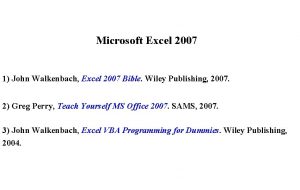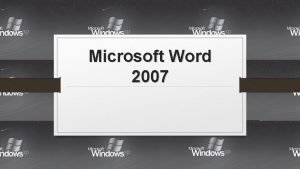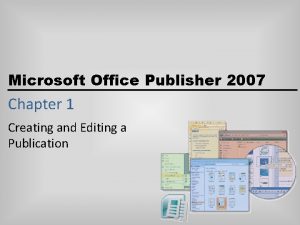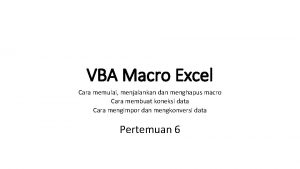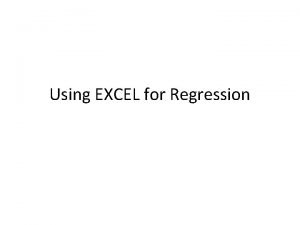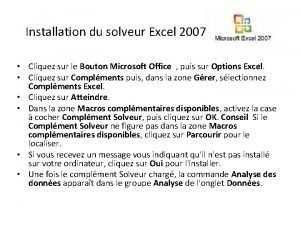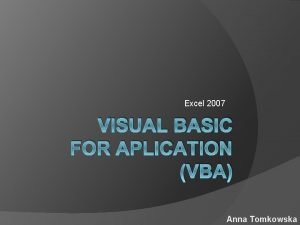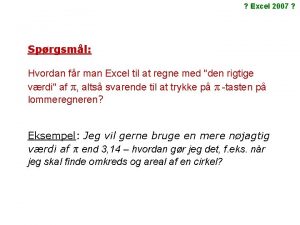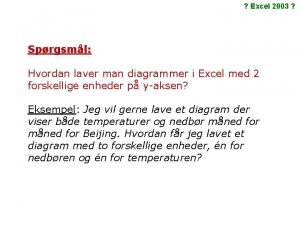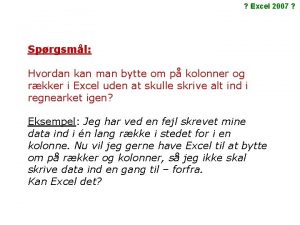Next MS EXCEL 2007 The Microsoft Excel is




















































- Slides: 52

Next

MS EXCEL 2007 The Microsoft Excel is on of the Microsoft Office suite of programs. Its primary function is to perform calculations, analyze information and manage lists spreadsheet. To start MS Excel 2007 using the Windows Start Menu • Click Start • All Programs • Microsoft office • Microsoft Excel 2007. Next

How to open MS Excel 2007

WELCOME TO MS EXCEL !! Next

THE MS EXCEL SCREEN ELEMENTS Title bar Menu bar Tool bar Cell Reference Formula bar Active cell Row Next Column

THE ELEMENTS OF EXCEL WINDOW Element (part) Job ﺍﻟﻤﺼﻄﻠﺢ ﺑﺎﻟﻌﺮﺑﻴﺔ Title bar Shows the name of the book Menu bar Provides access to the commands on the menus Tool bar Standard toolbar: contains buttons to help you select common commands, such as save, open, undo typing and print. Formatting toolbar: contains buttons to help you select formatting commands, such as font size, font style, bold alignment and font color. Row A horizontal line of cells. ﺻﻒ Column A vertical line of cells. ﻋﺎﻣﻮﺩ Active cell Display a thick border. You enter data into the active cell. ﺍﻟﺨﻠﻴﺔ ﺍﻟﻨﺸﻴﻄﺔ Cell reference (Name box) A cell’s address. For example, the cell at the intersection of column A and row 1 has the reference A 1. ﻋﻨﻮﺍﻥ ﺍﻟﺨﻠﻴﺔ Formula bar Allows you to calculate and analyze data or change information in a worksheet. ﺷﺮﻳﻂ ﺍﻟﺼﻴﻐﺔ ﺍﻟﺮﻳﺎﺿﻴﺔ Row heading A number identifies each row. ﻋﻨﻮﺍﻥ ﺻﻒ Column heading A letter identifies each column. ﻋﻨﻮﺍﻥ ﻋﺎﻣﻮﺩ ﺷﺮﻳﻂ ﺍﻟﻘﻮﺍﺋﻢ ﺍﻷﺪﻭﺍﺕ ﺷﺮﻳﻂ ﺟﺰﺀ ﺍﻟﻤﻬﺎﻡ

ENTER DATA: v Enter numbers in a cell. - Select the cell in which you want to enter a number and type in the number. - The number you type appears in the active cell and the formula bar. - Press the Enter Key to enter the number and move down one cell. - If you want to make the number a negative, type a minus sign in front it or enclose it in parentheses (i. e. brackets). - The numbers will be right aligned by default. v Enter text in a cell. - Click the cell where you want to enter text. Then type the text. - The text you type appears in the active cell and the formula bar. - Remember that to move to the next cell use the Tab Key. - To move down a cell press the Enter Key. - The text will be left aligned by default. Next

Long Words If text is too long to fit in a cell, the text will spill into he neighboring cell. If the neighboring cell contains data, Excel will display as much of the text as much as the column width allow. Long numbers If a number is too long to fit in a cell, Excel will display the number in scientific form or as number signs (#).

VENTER SYMBOLS OR SPECIAL CHARACTERS IN A CELL. - Select the Symbol command from the Insert menu.

SELECT CELL v Select a cell - Click the cell you want to select. - The cell becomes an active cell and displays a thick border. v Select a row(s) - Click the number of the row (Row Heading) you want to select - To select multiple rows, position the mouse over the number of the first row you want to select. Then drag the mouse until you highlight all the rows you want to select. Next

v Select a column(s) - Click the number of the column (Column Heading) you want to select. - To select multiple columns, position the mouse over the letter of the first column you want to select. Then drag the mouse until you highlight all the columns you want to select. v Select a group of cells -Position the mouse over the first cell you want to select. - Drag the mouse until you highlight all the cells you want to select. Next

v Select non-adjacent cells. - Click on the first cell you wish to select. Depress the Control Key (Ctrl). - Click on the other cell you wish to select. Release the Control key when you have finished. Complete a series Excel can save you time by completing a text or number series for you. v Complete a Text Series. - Enter the text you want to start the series. - Click the cell containing the text you entered. - Position the mouse over the bottom right corner of the cell, (Auto Fill Hand). - Drag the mouse + over the cells you want to include in the series. - The cells display the text series. Auto Fill Hand

v Complete a Number Series. - Enter the first two numbers you want to start the series. - Click the cells containing the numbers you entered. - Position the mouse over the bottom right corner of the cells, (Auto Fill Hand). - Drag the mouse + over the cells you want to include in the series. - The cells display the number series. Auto Fill Hand Next

Copy , Move , Delete v Use the copy and paste tools to duplicate cell contents in another part of a worksheet. -Select the cell or range you wish to copy. -From the edit menu select copy. or press Ctrl+C, or right click on the mouse select copy or click on the copy icon on the standard toolbar. -Switch to the required destination program. -Place the cursor where you want the data to appear. -select paste from the edit menu or press Ctrl+V or right click on the mouse select copy or select the paste icon from the standard toolbar. v Delete cell contents in a selected cell range. -Select the cell or range that you want to delete. -From the edit menu select delete.

Search and replace v. Use the search command for specified cell content. -Place the insertion point where you want to begin the search. -Select the find command from the edit menu. or press Ctrl+F to display the find dialog box.

v. Use the replace command from the edit menu. or press Ctrl+H to display the replace dialog box.

Rows and Columns v To insert a row into worksheet. -Excel will insert a row above the row you select. (to select a row , click the row number). -To select more than one row, drag the mouse pointer across the required row headings (with mouse button depressed). -Click insert menu Rows. Or right click over the selected row(s) to display a pop-up menu, select insert. 1. Select a row 2. Insert a row

The new row appears and all rows that follow shift downward. Next

v. To insert a column into worksheet -Excel will insert a column to the left of the column you select. (To select a column, click the column letter). -To select more than one column, drag the mouse pointer across the required column headings (with mouse button depressed). columns -Click insert menu Or right click over the selected columns(s) to display a pop-up menu , select insert. 1. Insert a column 2. Select a column Next

The new column appears and all the columns that follow shift to the right. Next

Modify column width and row height v. To change the width of a column -Position the mouse Over the right edge of the column heading. -Drag the column edge until the dotted line displays the column width you want. -Fit longest item To Change a column width to fit the longest item in the column, double-click the right edge of the column heading. Next

Next

v. To change the height of a row -Position the mouse Over the bottom edge of the row heading. -Drag the row edge until the dotted line displays the row height you want. -Fit tallest item To change a row height to fit the tallest item in the row-double-click the bottom edge of the row heading.

Insert a worksheet You can insert a new worksheet to add related data to your workbook. Each workbook you create automatically contains three worksheets. You can insert as many new worksheets as you need. Click insert worksheet First step Next

Second step The new worksheet appears Third step

Delete a worksheet You can permanently remove a worksheet you no longer need from your workbook. Right-click the tab of worksheet you want to delete select delete. Delete sheet Or click edit

RENAME A WORKSHEET - Right click on the worksheet tab that you wish to rename. From the popup menu Displayed select the Rename command. - You can then type over the default worksheet name, which will become highlighted.

v. Change font of Data -Select the cells containing the data you want to a new font -Click in this area to display the list of the available fonts. -Click the font you want to use -The data changes to the font you selected. Next


v. Change size of Data -Select the cells containing the data you want to a new size. -Click in this area to display a list of the available sizes. -Click the size you want to use. Next

Next

v. Change cell color (Cell Shading). -Select the cells you want to change to a different color. -Click in this area to select a color from the Toolbar. -Click the color you want to use Next

To remove a color from Cells, repeat steps 1 to 3, Except select No Fill in step 3 Next

v Change Data Color. -Select the cells containing the data you want to different color -Click in this area to select a color from the Toolbar -Click the color you want to use Next

To remove a color from Cells, repeat steps 1 to 3, Except select Automatic in step 3 Next

v. Bold, Italic, Underline -Select the cells containing the data you want to change -Click one of the following buttons from the Toolbar. Bold Underline Italic v. Change alignment of Data -Select the cells containing the data you want to align differently -Click one of the following buttons from the Toolbar. Align left Center Align right Bold, Underline, Center, Font Size 12 points, Font color red Bold, Italic, Align Left, Font Size 10 points Next

CHANGE NUMBER FORMAT v. Change the number styles -Select the cells containing the number you want to change -Click one of the following buttons from the Toolbar. Currency Percent Comma v. Add or remove a Decimal Place -Select the cells containing the number you want to change -Click one of the following buttons from the Toolbar. Increase Decrease Next

-Enter a number in a cell -Right Click to display a pop-up menu, and select Format Cells, to display the format cells dialog box -Select Number, Currency, or Percentage from the category list. Next

Currency (dollar value) Decimal Places



Returns the average (arithmetic mean) of the arguments. Example : (find the average for each student. )

A dialog box appears. If the dialog box covers data you want to use in calculations , you can move the dialog box to a new location

Returns the average (arithmetic mean) of the arguments. Example : (find the Average for each student. )

Function Name Definition Syntax Max Returns the largest value in a set of values. MAX(number 1, number 2, …) Min Returns the smallest number in a set of values. Sum Adds all the numbers in a range of cells. Average Returns the average (arithmetic mean) of the arguments. Counts the numbers of cells that contain numbers and counts numbers within the list of arguments. Use COUNT to get the number of entries in a number field that is in a range or array of numbers. Count A Counts the number of cells that are not empty and the values within the list of arguments. Use COUNTA to count the number of cells that contain data in a range or array. Count. Blank Counts empty cells in a specified range of cells Number 1, number 2, … are 1 to 30 numbers for which you want to find the maximum value. MIN(number 1, number 2, …) Number 1, number 2, … are 1 to 30 numbers for which you want to find the minimum value. Sum(number 1, number 2, …) Number 1, number 2, … are 1 to 30 arguments for which you want the total value or sum. Average(number 1, number 2, …) Number 1, number 2, … are 1 to 30 numeric arguments for which you want the average. COUNT(value 1, value 2, …) Value 1, value 2, … are 1 to 30 arguments that can contain or refer to a variety of different types of data, but only numbers are counted. COUNTA(value 1, value 2, …) Value 1, value 2, … are 1 to 30 arguments representing the values you want to count. COUNTBLANK(range) Range is the range from which you want to count the blank cells






The End

 X.next = x.next.next
X.next = x.next.next Sebutkan ikon yang ada pada menu bar ms excel
Sebutkan ikon yang ada pada menu bar ms excel John walkenbach
John walkenbach Microsoft official academic course microsoft excel 2016
Microsoft official academic course microsoft excel 2016 Microsoft excel merupakan program aplikasi?
Microsoft excel merupakan program aplikasi? Tombol size button terletak di bagian pojok
Tombol size button terletak di bagian pojok Microsoft project 2007
Microsoft project 2007 Office visio professional 2007
Office visio professional 2007 Microsoft project 2007 tutorial
Microsoft project 2007 tutorial Ms publisher 2007
Ms publisher 2007 Microsoft groove 2007
Microsoft groove 2007 Microsoft live meeting 2007
Microsoft live meeting 2007 Microsoft office 2007 wikipedia
Microsoft office 2007 wikipedia Ms project 2007 training
Ms project 2007 training Virtual pc player
Virtual pc player Cara mengaktifkan macro di excel 2010
Cara mengaktifkan macro di excel 2010 Simple linear regression excel
Simple linear regression excel Powerpivot 自習書
Powerpivot 自習書 Ods to excel
Ods to excel Solveur excel 2007
Solveur excel 2007 How to use goal seek in excel 2010
How to use goal seek in excel 2010 Solver excel 2007
Solver excel 2007 Visual basic excel 2007
Visual basic excel 2007 Regression in excel 2007
Regression in excel 2007 Dashboard excel 2016
Dashboard excel 2016 Anova excel 2007
Anova excel 2007 Hvordan får man excel til at regne
Hvordan får man excel til at regne Pmt function in excel 2007
Pmt function in excel 2007 Word les
Word les Microsoft office decision tree
Microsoft office decision tree Powerpivot excel 2007
Powerpivot excel 2007 Realizar
Realizar Histogram in excel 2007
Histogram in excel 2007 Diagrammer i excel
Diagrammer i excel Que representa
Que representa Gradiente aritmetico excel
Gradiente aritmetico excel Solver
Solver Lær excel 2007
Lær excel 2007 Standard deviation
Standard deviation Microsoft official academic course microsoft word 2016
Microsoft official academic course microsoft word 2016 Windows startwarren theverge
Windows startwarren theverge Microsoft official academic course microsoft word 2016
Microsoft official academic course microsoft word 2016 Hát kết hợp bộ gõ cơ thể
Hát kết hợp bộ gõ cơ thể Ng-html
Ng-html Bổ thể
Bổ thể Tỉ lệ cơ thể trẻ em
Tỉ lệ cơ thể trẻ em Voi kéo gỗ như thế nào
Voi kéo gỗ như thế nào Chụp phim tư thế worms-breton
Chụp phim tư thế worms-breton Alleluia hat len nguoi oi
Alleluia hat len nguoi oi Môn thể thao bắt đầu bằng từ đua
Môn thể thao bắt đầu bằng từ đua Thế nào là hệ số cao nhất
Thế nào là hệ số cao nhất Các châu lục và đại dương trên thế giới
Các châu lục và đại dương trên thế giới Cong thức tính động năng
Cong thức tính động năng


